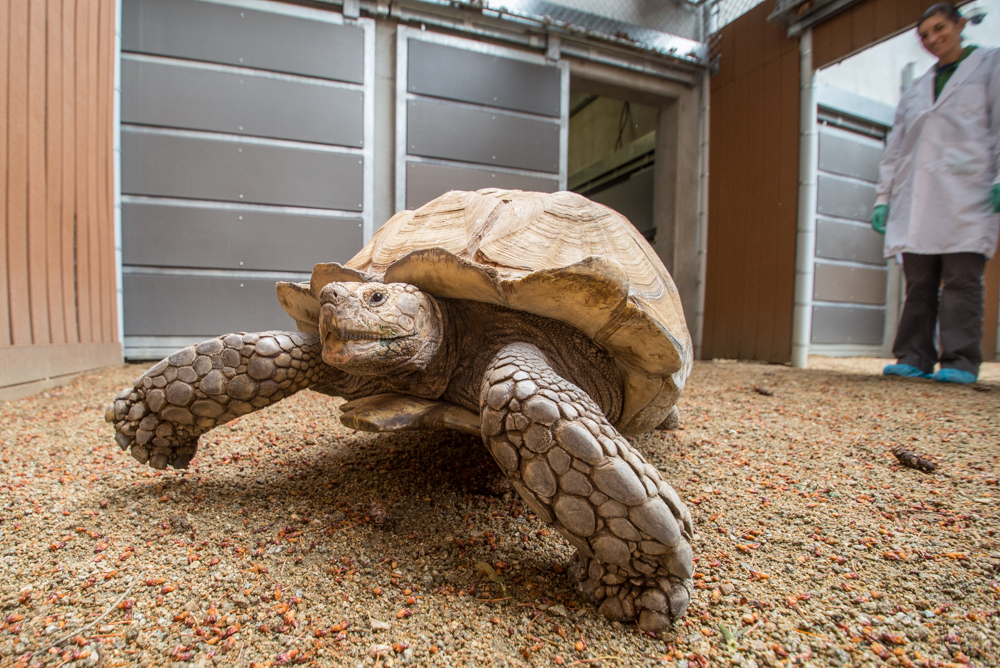Animal moves are part of the growth and operations of every zoo accredited by the Association of Zoos and Aquariums (AZA). When animals at Seneca Park Zoo are set to be transferred to other locations, or when animals from other zoos need to move to Seneca Park Zoo, animal care staff guide the process to ensure that it goes smoothly. Animals are moved for a variety of reasons, but many do so in order to join a new social group and begin breeding as part of recommendations from the AZA Species Survival Plan (SSP) for their species.
Earlier this year, the Zoo moved two very different animals–two African spurred tortoises and a California sea lion–to other zoos. We talked to two members of our animal care staff to learn more about what these moves entailed and how they are creating opportunities, both here at Seneca Park Zoo and at other institutions, for education and conservation.


Why were Dozer and Shelly moved to the Oregon Zoo?
As Seneca Park Zoo moves forward with expansion plans, it makes sense to strategically plan for the future to make sure we find good homes for some of the animals in the collection. We will need to remove some current exhibits to design and build new ones. The Oregon Zoo was looking for large African spurred tortoises. One of their Curators put out an inquiry among AZA Zoo’s and the time was right for us to move ahead with future plans.
What will make the Oregon Zoo such a great home for them?
African spurred tortoises (commonly referred to as sulcatas) are the third largest tortoise species in the world. It is not uncommon for an African spurred tortoise to live beyond 80 years old. Males can grow up to about 200 pounds and females will top the scales at well over 100 pounds! In the past, the African spurred tortoise was often seen in the pet trade. Due to their immense size and longevity the ideal home for this species is a zoo. The Oregon Zoo has renovated a brand new exhibit specifically for African spurred tortoises. We also know that they will be given excellent quality care in Portland!
Were there any special accommodations needed to be made to ship this species?
First of all, it’s not easy to ship large tortoises to Oregon. Special arrangements were made with FedEx and a staff member from Oregon Zoo flew to Rochester to personally fly with Dozer and Shelly on their journey back to Oregon. The shipping crates were designed and custom built here at the Zoo by our lead Maintenance department craftsman, Jim Paxon. He does an excellent job at building shipping crates for any of our collection – sometimes with unique features. For large tortoises, it is really important that they can turn around, but still not create enough leverage to break the crate – especially while in flight. It’s also important to build a crate that is tall enough that a tortoise can’t just break the lid off by standing up.
How does Dozer and Shelly’s move fit in to preparations for the Master Plan?
Moving them will allow us to move forward with Master Planning and design to renovate the first area when entering the zoo. Their exhibit is intended to be removed as part of the Master Plan development. The new area at the front of the zoo will focus on tropical Asia and Africa. Therefore, taking advantage of an opportunity to place them at such a great institution will help us immensely in moving forward as planned.Zoo Keeper James Weinpress on moving P.J. the California sea lion to Riverbanks Zoo


What specific accommodations were made for P.J. during the move? What factors were necessary for the success of the transfer?
The transfer process was a long-term collaboration between the staff at both Seneca Park Zoo and Riverbanks Zoo. While the curator staff at both facilities worked out the logistics of the trip, the animal care staff met to plan and implement specific training that would ensure P.J. would be well prepared for his journey. Since P.J. would be traveling in a large transport crate, he was given access to it 24/7 which would allow him to investigate and become comfortable around it. For several days before the move, he was actively trained to go into his transport crate, one small step at a time, until he was going completely inside of it when asked by his trainers. Once inside, he was given lots of fish and praise. This made going into the crate one of his favorite places to be since he was always rewarded inside. The other sea lions at Seneca Park also enjoyed having it around, often sleeping in it at night!
How much did P.J. eat during the transfer?
On the day of his trip, P.J.’s morning session was carried out as it would be any other day. He earned fish rewards as he worked through his behavioral routine. One of our biggest goals was to make sure P.J. remained as calm as possible and starting his day like any other was a big part of that. P.J. ate again once he arrived at his new home at Riverbanks Zoo. This was a great sign that he was not stressed and feeling good after his long transport!
How did you moderate temperature during the trip?
Marine mammals such as sea lions and seals can easily overheat if they are out of water for too long. For this reason, keeping P.J. cool was a top priority. The transport truck had several pump handle misters that could be used to lightly mist P.J. with cold water if necessary. There were also several large containers of ice available that slowly melted over his transport crate and provided him with an occasional cool shower. Additionally, a powerful air conditioning system was set on “high” for the entire trip. I wore two sweatshirts with the hood up for the entire 13 hour trip! I was able to check on P.J. every 45 minutes to take the ambient temperature of the truck and to monitor his behavior.
How did P.J. begin acclimating to his new habitat when he first arrived?
P.J. spent the first two days becoming familiarized with his new home taking in new sights, smells, and sounds. He was able to observe the other three sea lions that he would be sharing his exhibit with. He very quickly became interested in interacting with two of the younger males close to his age named Ranger and Maverick. They were first allowed to interact through a door, getting to know one another through sight, smell, and body language. After observing their behavior, Riverbanks keepers then allowed the three boys access to one another and they immediately began to socialize as all sea lions do, chasing and playing with one another in and out of the water.
When is the transfer considered successful?
In my opinion, a transfer is considered a success when the animal arrives at their new home as quickly and calmly as possible. By these standards P.J.’s transport was an overwhelming success! Every step, from P.J. being asked to go into his transport crate to the trip to South Carolina and his acclimation to his new home, went smoothly and as planned. Throughout the entire process, P.J. exhibited behaviors appropriate for his species and to his own personality. These were both signs that throughout his journey down south, he was very comfortable.













